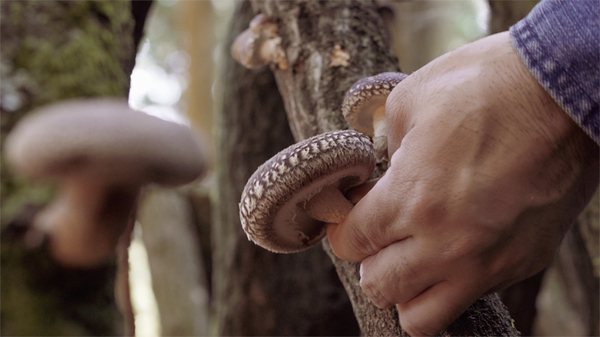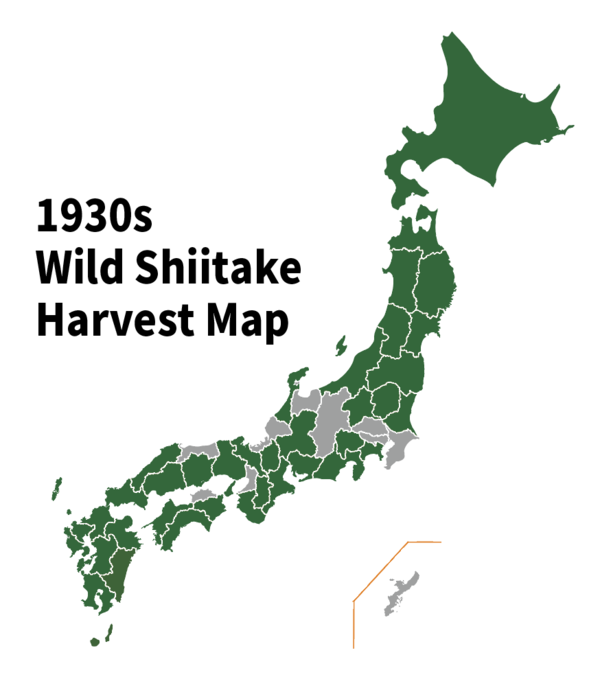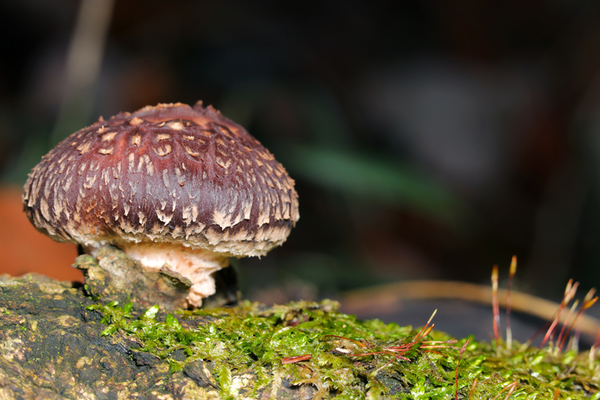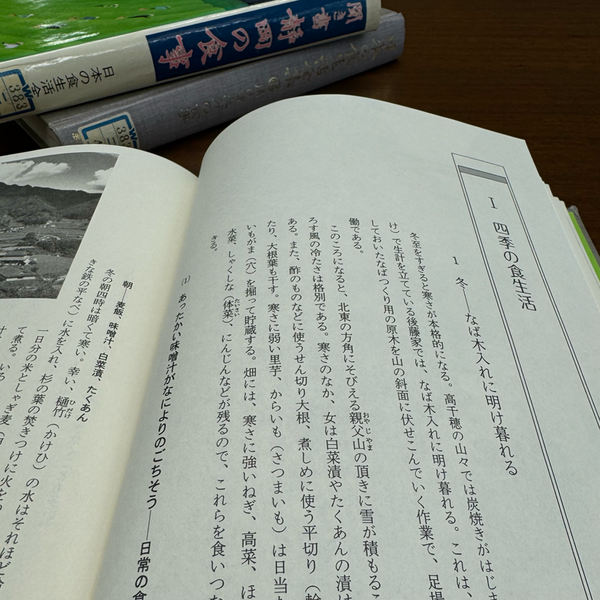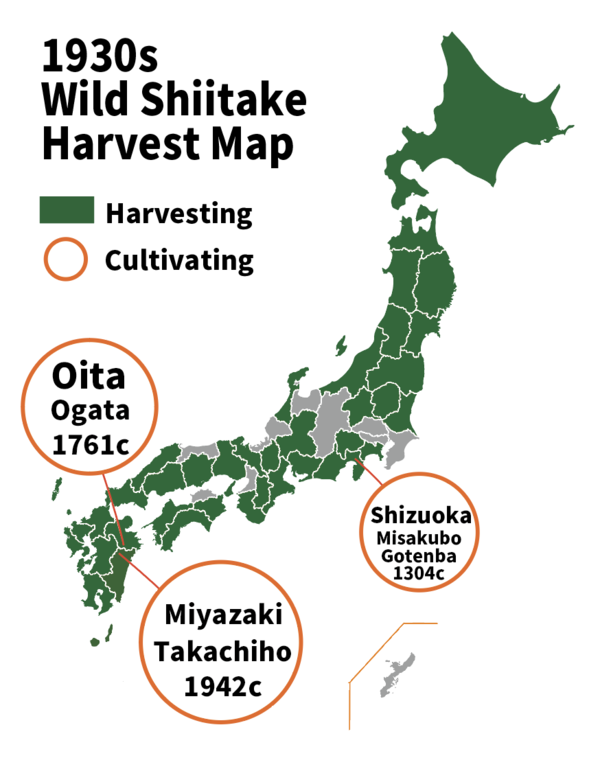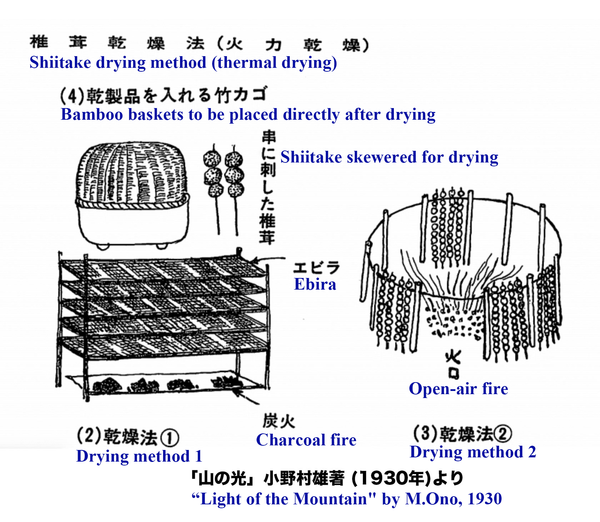Shiitake mushroom sanctuary in Japan.
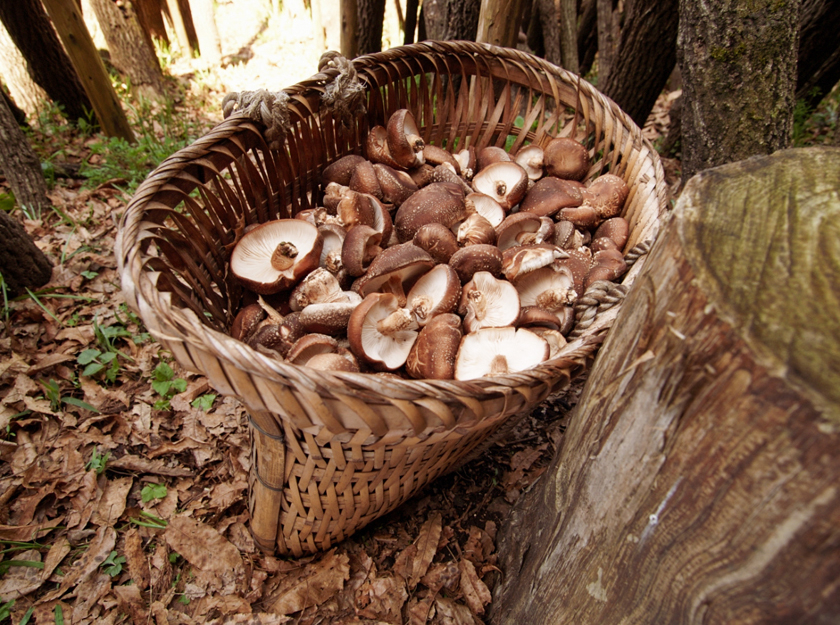
Tag: #Satoyama #SatoyamaCulture #WildShiitake #MushroomForaging #WildMushrooms #ShiitakeMushrooms #ForestForaging #SustainableForaging #NatureForaging #MushroomHunting #WildFood #NaturalHabitat
Table of Contents
In 1930, Japan could pick wild shiitake in the mountains for free!
The 50-volume "Complete Collection of Dietary Habits of Japan" (Nobunkyo) is Japan's largest food culture database, created by interviewing 5,000 speakers at 300 locations across the country about their dietary habits around 1930. The following facts were found by tabulating articles related to "shiitake mushrooms" without omission, since keyword searches can be performed online.
1) Wild shiitake mushrooms grew in Satoyama, so you could pick shiitake all over Japan!
2) If you cut a sawtooth oak, and slit the log with a hatchet, and leave it, shiitake grew from it!
3) Takachiho-go was the center of shiitake cultivation!
The "Complete Collection of Japanese Food Culture" was compiled based on interviews with people who were involved in food preparation from 1925 to around 1935, mainly in the 1930s. The book is mainly a compilation of recipes and other information about food culture, but it also includes detailed descriptions of local specialties. By searching for the keyword "shiitake" we were able to determine the prefectures where wild shiitake could be gathered from the mountains and the places where shiitake could be easily grown by machete cultivation in an era when inoculation techniques were not yet available.
Almost all over the country, shiitake was wild.
By tallying up the mentions of shiitake being gathered in the mountains, we have color-coded in green the prefectures where shiitake were growing wild in the forests around 1930.
Shiitake picking was mentioned only in the "Complete Collection of Food Habits in Japan," so looking at the results, which are colored green almost all over Japan, it seems that shiitakes were commonly grown deep in the mountains, even in the gray areas.
For example, even in Tokyo, wild shiitake mushrooms must have grown deep in the western mountains, such as Mt. Takao, and in Nagano Prefecture, there is a possibility that shiitake mushroom records may have been omitted because the area was too much of a mushroom paradise.
Free all-you-can-eat!
"Mushrooms are plentiful in the mountains in autumn. We are blessed with many varieties, including shiitake. They are simmered and made into miso soup. With these seasonal ingredients, we not only savor them when they are in season, but we also store them in salted or dried form and eat them out of season as well." (Aomori Prefecture)
"In August, after the autumn storm passes, a basketful of shiitake is harvested at a time, and every household becomes enthusiastic about picking shiitake. Freshly picked shiitake are sometimes cooked, but most of the time they are preserved as dried shiitake." (Tochigi Prefecture)
"In the fall, Mt. Minobu is a treasure trove of mushrooms, with more than enough shiitake and other mushrooms to fill one's backpack. They are used to make soup or simmered in soy sauce. The shiitake mushrooms can be dried and preserved, and when added to umani-braised, the taste and aroma are both delicious." (Yamanashi Prefecture)
This is a lively description of how shiitake and other mushrooms are being picked as much as they can in the mountains all over Japan. They were growing in the mountains without cultivation to begin with!
Wild shiitake mushrooms growing on fallen trees
DNA analysis studies at Harvard University have shown that these wild shiitakes have been growing wild in Japanese forests since the Jomon period, and that they spread from Japan to mainland China and the Korean peninsula.
Mapping estimates of Shiitake spore concentrations.
"While collecting firewood, we would cut down sawtooth oak and other oak trees in the mountains and hang them in the damp area under the trees in the garden of the house, using bamboo as a support. In spring, shiitake grow from these trees. After a few warm days, they produce enough shiitake for home use, which are picked and chopped into thin strips and cooked with fried tofu and carrots in a soy sauce seasoning." (Shizuoka Prefecture)
It seems that if there were enough shiitake spores to fly around, shiitake mushrooms would grow naturally without slitting with a machete. In this era, when shiitake plugs had not yet been invented, shiitake mushrooms would not grow unless shiitake spores flew to them.
Therefore, I tabulated the number of words in the article from mild cultivation, such as shiitake mushrooms growing when a log was left unattended, to the part where cultivation as a profession was written. Below are the lands where cultivation was done and the number of words in the articles. The higher the number of words, the more shiitake spores must have been floating thickly in the area.
Miyagi Prefecture
Kamigun Onoda Town: 33 characters, Vol. 4, p. 242
Shizuoka Prefecture
Iwata District, Misakubo Town: 977 characters, Vol. 22, pp. 283-284, 294-295, 298-299
Gotemba City: 327 characters, Vol. 22, pp. 41, 59-60
Kanagawa Prefecture
Ashigarakami District, Yamakita Town: 144 characters, Vol. 14, pp. 238-240, 346-347
Nara Prefecture
Yoshino District, Totsukawa Village: 190 characters, Vol. 29, pp. 286-287, 299-302
Tokushima Prefecture
Naka District, Kitou Village: 111 characters, Vol. 36, p. 151
Ehime Prefecture
Ochi District, Tamagawa Town: 129 characters, Vol. 38, pp. 294-295
Fukuoka Prefecture
Yame District, Kuroki Town: 102 characters, Vol. 40, pp. 259-261
Oita Prefecture
Ono District, Ogata Town: 1761 characters, Vol. 44, pp. 108-109, 110-111, 122, 136-137, 143-146, 342-347
Miyazaki Prefecture
Nishi-Usuki District, Takachiho Town: 1942 characters, Vol. 45, pp. 14-15, 16, 20-21, 26-28, 43-45, 51-52
Koyu District, Nishimera Village: 67 characters, Vol. 45, pp. 135-136
Nichinan City: 37 characters, Vol. 45, p. 343
Kumamoto Prefecture
Aso Region: 15 characters, Vol. 43, pp. 353-357
Kagoshima Prefecture
Satsuma District, Iriki Town: 73 characters, Vol. 46, pp. 122-124
Nishinoomote City: 81 characters, Vol. 46, pp. 261-263
The center of wild shiitake mushrooms was here.
And as a result of the character count, the following are the areas where shiitake cultivation was written about in particularly long sentences. These areas seem to have been a sanctuary for wild shiitake mushrooms, where shiitake spores were thick in the air.
What makes these three areas different from the others is that merchants went out of their way to buy shiitake mushrooms there, and the reputation of the area as a famous shiitake mushroom growing area seemed to have been established by the early Showa period. In addition, machete cultivation was practiced, in which a slit is made in the log with a machete to make it easier for shiitake spores to take root.
No. 1 Takachiho Town (Miyazaki Prefecture), 1942 words: "The dried shiitake mushrooms thus produced are bought at a good price by merchants from Higo (Kumamoto) and Bungo (Oita), in addition to local merchants." Local and Higo merchants buy the dried shiitakes while they are still warm, competing with their rivals in a shouting match. We are happy when we get a good price. The sight of shiitake mushroom merchants carrying large cotton packs of shiitake mushrooms home is like that of Daikoku-sama."
No. 2 Ogata Town (Oita Prefecture),1761 characters: "It was around this time that Oita's shiitake mushrooms gained fame, winning the top prize at the Kyushu-Okinawa Eight Prefectures Union Exhibition in 1921 and a gold medal at an exhibition in Tokyo the following year."
No. 3 Misakubo/Gotemba (Shizuoka Prefecture), 1304 characters: "Some merchants who come to buy dried Shiitake mushrooms even stay overnight to wait for them to dry.
Note that Takachiho Town and Ogata Town are adjacent to each other, separated by the north-south of Mt.Sobo/Katamuki range.
Dried Shiitake Mushroom Production in 1930 (7th Statistical Table of the Ministry of Agriculture and Forestry)
- Miyazaki Prefecture: 223,643 kg
- Oita Prefecture: 200,904 kg
- Shizuoka Prefecture: 188,740 kg
Number of characters for shiitake cultivation in the "Complete Collection of Dietary Habits of Japan"
- Takachiho Town, Miyazaki Prefecture: 1,942 characters
- Ogata Town, Oita Prefecture: 1,761 characters
- Misakubo/Gotemba, Shizuoka Prefecture: 1304 characters
Validity of Analysis Method
The rank order of the number of letters in the "Complete Collection of Dietary Habits of Japan" and the rank order of the dried shiitake mushroom production statistics as of 1930 coincide, confirming that the analysis based on the count of letters correlates with the actual production volume. This data concordance suggests that the character counts likely reflect the prosperity and passion of shiitake cultivation in the area. In this matter, confirming with multiple data sources can increase the reliability of the analysis by character counts. The number of pages in each volume of the "Complete Collection of Japanese Foods" varied from 348 to 400, centered on page 384, but since the comparison is based on the number of descriptions of shiitake mushrooms within each region, the margin of error is acceptable enough to identify overall trends.
The areas of the place names as of 1930 are as follows
Takachiho: "Takachiho-go is a large area centered on Takachiho Town and including Kamino, Iwato, Tabaru, Nanaori, Iwaigawa, Kuraoka, Sangasho Village, as well as Morotsuka and Shiiba Village in Higashi-usuki-gun. It is located in the northernmost part of Miyazaki Prefecture, and mountains and forests occupy 97 percent of the land." Vol. 45, 51-52.
Ogata Town: "April 1, 1889 - Ogata Village was formed from the areas of Baba, Kami-jizai, Shimo-jizai, Jikumaru, Ogose, Inoue, and Nojiri Villages under the town-village system." From wikipedia
Cultivation method at that time in Takachiho
"In the forests of Takachiho, there are abundant trees such as kunugi, hasako (konara), and shide (shide), which are used to grow shiitake mushrooms, as well as shi and kashi, which are used to make charcoal for drying shiitake mushrooms. The Goto family in Kamino Village, Nishi-usuki-gun, is also a farmer who earns his living by shiitake mushroom cultivation.
Shiitake mushroom cultivation begins with logging in the fall. It is the work of men to fell logs for shiitake cultivation, using saws, axes, machetes, and yoki (small axes). The amount of work per day logged by one person from morning to night is called a "Hitoriku (one-man block)." Logs are cut into 1.2-meter lengths called this cutting work "Tamagiri", slit with a machete, and laid down on the slope of the mountain in alternating rows of two.
The Hitoriku of the logging is about 66 square meters when it is tucked in. The branches and leaves are covered with the logs and wait for the shiitake spores to enter the logs. This process is called "Ireki."
After about 20 months, the shiitake logs are taken down to the Hodaba (a damp area facing south to east where shiitake is grown). This is a difficult task because the work is done on poor footholds.
Also in autumn, a big task called "Nabaki tsukuri" awaits. The shiitake logs are soaked in water overnight and then beaten twice at each end while calling out "Oba, Oba" to make them absorb water. Sometimes, a late typhoon is used for natural utilization. Once the shiitake logs have absorbed enough water, they are put back in the hodaba and wait for the shiitake to grow out of them.
Shiitake finally grow in the second year from Ireki. In the fall, shiitake are growing on the shiitake logs that were put into Hodaba two years ago, so there will be a harvest of them.
The harvested shiitake mushrooms are dried in a shack. The shiitake mushrooms are placed in a Hibachi (an unglazed brazier) filled with charcoal, on top of which is placed an Ebira (a flat bamboo box) in which the shiitake mushrooms are laid out to dry slowly. Depending on the moisture content, it takes about 20 to 25 hours. Drying is the most important part of making dried shiitake mushrooms, and it requires the most attention. The fire is checked every two hours. Managing the fire is difficult, and it is a battle against sleepiness. However, merchants would be waiting to buy them, so he would try his best to keep the fire burning so that he could produce good dried shiitake mushrooms, resisting the urge to sleep.
The dried shiitake mushrooms produced in this way were bought at a good price by local merchants as well as those from Higo (Kumamoto) and Bungo (Oita). At home, shiitake mushrooms that cannot be sold are used to make soup stock, cooked rice, nimono braised, and other dishes."
Quoted from vol. 45, pp. 43-45.
A Shiitake Master from Takachiho Talks about His Memories of Machete Cultivation
Mr Hirosue, a shiitake master from Takachiho, shares his memories of growing shiitake mushrooms with his father.
It was revealed that Kisaku Mori, the first president of Mori Sangyo, stayed at the home of Kunizo Hirosue in Taguchino, Takachiho for a few days to learn the techniques of machete cultivation before he invented shiitake plugs in 1942.
Thirty years later, in 1970, Sugimoto Shiitake built its first factory in the same place in Taguchino.
Summary.
'The wild shiitake mushrooms were growing in the mountains without cultivation and everyone could eat as much as they wanted.' (Vol. 9, 120-121, Vol. 35, 87-88)
Near the forest, shiitake mushrooms grew just by cutting logs and leaving them in front of houses. (Vol. 22, 41-41, 22, 59-60)
In famous shiitake growing areas, shiitake mushrooms grew even better when the logs were chipped with a machete. (Vol. 44, 110-111, Vol. 44, 342-347)
Wild shiitake mushrooms were gathered in abundance in spring and autumn, so they were dried and eaten in other seasons. (Vol. 5, 316-318,Vol. 45, 223-224)
For household use, shiitake mushrooms were dried in the sun or wind. (Vol. 10, 101-101,35, 219-221)
In production areas, shiitake mushrooms were dried over charcoal or firewood. (Vol. 22, 283-284,Vol. 45, 43-45)
In the early Showa period, long before the shiitake plugs were produced, the following three places were recognised as famous production centres for dried shiitake mushrooms. Takachiho (Miyazaki), Ogata (Oita) and Misakubo/Gotemba (Shizuoka). (vol. 22, 298-299, vol. 44, 136-137, vol. 45, 43-45)
And this solves the mystery as to why there are so few ancient documents related to shiitake mushrooms in Japan. Mushrooms that grow a lot in the mountains around there are nothing special.
In Japan, it is said that the machete cultivation of shiitake mushrooms, in which machetes are used to slit the logs, began in the Edo period (1603-1868), and there was a theory that shiitake mushrooms were introduced to Japan from China because records of their cultivation appeared in ancient documents in China.
In reality, however, the opposite was true and Japan was the home of shiitake mushrooms. In any case, there were plenty of shiitake mushrooms growing in the mountains without cultivation.
Moreover, DNA analysis at Harvard University has shown that shiitake mushrooms spread from Miyazaki Prefecture to mainland China before the Jomon period. This shows that Takachiho has been a sanctuary for shiitake mushrooms from the Jomon period to the present day!
Takachiho's shiitake basket. Narrow at the bottom and wide at the top so that the shiitake mushrooms below are not crushed.
Please also see the following blogs.

